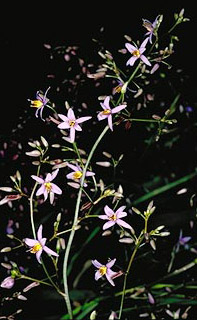Common name:
Blue Flax Lily, Anther Flax Lily
Family name:
Liliaceae
Botanical name:
- Dianella spp
- Dianella revoluta var. revoluta
Flowering/fruiting season:
October - December
Location:
- Uncommon in ACT (Burbidge & Gray, 1976:100)
- Grassy hillsides, eg Aranda bushland
- '… found in all States in a variety of habitats from heath to open forests and woodlands' (Stewart & Percival, 1997:17)
|
 |
 |
Use:
- Food, technology, medicine
- Leaf fibres used, fruits eaten raw and the roots pounded and cooked on hot rocks (Fraser & McJannett, 1993:70)
- '… blue fruits and shiny black seeds of most Dianella species are eaten raw. They have a sweet flavour, which becomes nutty once the seed is chewed. (Stewart & Percival, 1997:17)
- 'The leaf was split into two down the midrib and rolled in the manner of string to make a tie.' (Zola & Gott, 1992:59)
- 'Dianella caerulea leaves are used to make a high-pitched whistle .'(Wreck Bay Community & Renwick, 2000:45)
- 'Roots boiled and drunk as tea as medicine for colds (D. longifolia)' (Gott, 1995)
Notes:
Although the fruit can be eaten, it is not a good idea to eat too many (Gott, 1995)
Language names:
murmbal : Lake Hindmarsh (Zola & Gott, 1992)
Horticulture :
Propagate from seed or by division; most situations suitable (Wrigley & Fagg, 1998:152)
Similar species:
Nodding Blue Lily Stypandra glauca has similar flowers, later in season; leaves form massive clump (Fraser & McJannett, 1993:71)
Use code:
FRT, ROOT, SEED
« « Go Back | Return to Top of Page

